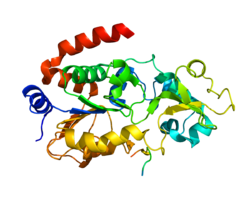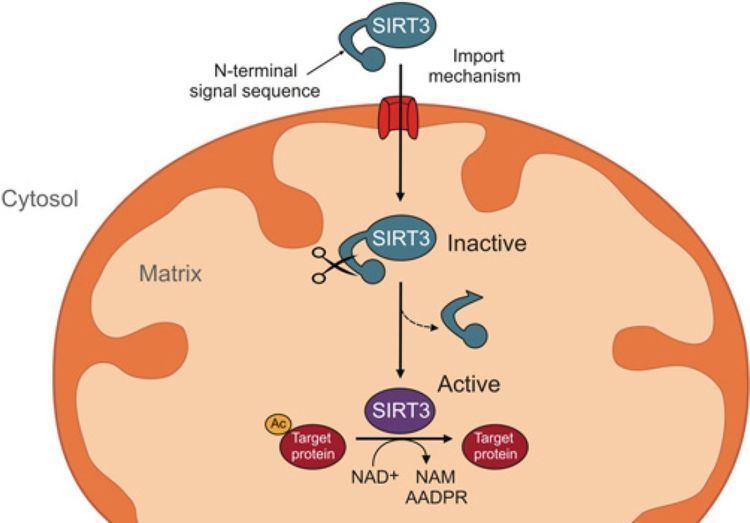Species Human Entrez 23410 | Human Mouse Ensembl ENSG00000142082 | |
 | ||
Aliases SIRT3, SIR2L3, sirtuin 3 External IDs MGI: 1927665 HomoloGene: 81827 GeneCards: SIRT3 | ||
NAD-dependent deacetylase sirtuin-3, mitochondrial also known as SIRT3 is a protein that in humans is encoded by the SIRT3 gene [sirtuin (silent mating type information regulation 2 homolog) 3 (S. cerevisiae)]. SIRT3 is member of the mammalian sirtuin family of proteins, which are homologs to the yeast Sir2 protein. SIRT3 exhibits NAD+-dependent deacetylase activity.
Contents

Members of the sirtuin family are characterized by a sirtuin core domain and grouped into four classes, and the protein encoded by this gene is included in class I of the sirtuin family. The human sirtuins have a range of molecular functions and have emerged as important proteins in aging, stress resistance and metabolic regulation. Yeast sirtuin proteins are known to regulate epigenetic gene silencing and suppress recombination of rDNA. In addition to protein deacetylation, studies have shown that the human sirtuins may also function as intracellular regulatory proteins with mono ADP ribosyltransferase activity.

Structure

SIRT3 is a soluble protein located in the mitochondrial matrix, and contains a mitochondrial processing peptide at the N-terminus. A set of crystal structures of human SIRT3 have been solved, including an apo-structure with no substrate, a structure with a peptide containing acetyl lysine of its natural substrate acetyl-CoA synthetase 2, a reaction intermediate structure trapped by a thioacetyl peptide and a structure with the dethioacetylated peptide bond. These structures show the conformational changes induced by the two substrates required for the reaction, the acetylated substrate peptide and NAD+. In addition, a binding study by isothermal titration calorimetry suggests that the acetylated peptide is the first substrate to bind to SIRT3, prior to NAD+.
Mitochondrial

Three sirtuins, SIRT3, SIRT4 and SIRT5, are located in mitochondria and have been implicated in regulating metabolic processes. Endogenous SIRT3 is a soluble protein located in the mitochondrial matrix. Overexpression of SIRT3 in cultured cells increases respiration and decreases the production of reactive oxygen species. Fasting increases SIRT3 expression in white and brown adipose tissue (WAT and BAT, respectively) and overexpression of SIRT3 in HIB1B brown adipocytes increases the expression of PGC-1α and UCP1, suggesting a role for SIRT3 in adaptive thermogenesis BAT. BAT is different from WAT because it harbors large numbers of mitochondria and is important for thermogenesis in rodents. Thermogenesis in BAT is mediated by the uncoupling protein 1 (UCP1), which induces proton leakage and thereby generates heat instead of ATP. Mechanistic insights into how SIRT3 affects thermogenesis in BAT is lacking and whether SIRT3 affects UCP1 activity directly is not known.
In addition to controlling metabolism at the transcriptional level, sirtuins also directly control the activity of metabolic enzymes. In Salmonella enterica, the bacterial sirtuin CobB regulates the activity of the enzyme acetyl-coenzyme A (acetyl-CoA) synthetase. As mentioned above, orthologs of acetyl-CoA synthetase exist in the cytoplasm (AceCS1) and in mitochondria (AceCS2) in mammals. The presence of the sirtuin deacetylase SIRT3 in the mitochondrial matrix suggests the existence of lysine acetylated mitochondrial proteins. Indeed, SIRT3 deacetylates and activates the mammalian mitochondrial acetyl-coA synthetase (AceCS2). Furthermore, SIRT3 and AceCS2 are found complexed with one another, suggesting a critical role for control of AceCS2 activity by SIRT3.
Nuclear
In addition to its reported mitochondrial function, some researchers have proposed a very small pool of active nuclear SIRT3 exists. This pool is reported to consist of the long form of SIRT3 and has been suggested to have histone deacetylase activity. The observation that SIRT3 has nuclear activity came from a report that SIRT3 protected cardiomyocytes from stress mediated cell death and that this effect was due to deacetylation of a nuclear factor, Ku-70.
Clinical significance
There is a strong association between SIRT3 alleles and longevity in males.
Aging and carcinogenesis
There is also a significant body of published literature suggesting a strong mechanistic link between mitochondrial function, aging, and carcinogenesis.
Sirt3 functions as a mitochondrial tumor suppressor protein. Although some evidence attributes SIRT3 activity in bypassing growth arrest in bladder carcinoma cells via regulation of p53 in the mitochondria. Damaged and aberrant mitochondrial function, similar to gene mutations, may be an early event that ultimately leads to the development of cancers. Mice genetically altered to delete Sirt3 develop estrogen and progesterone receptor (ER/PR) positive breast mammary tumors. In tumor samples from women with breast cancer, SIRT3 expression was decreased, as compared to normal breast tissues. Thus, the Sirt3 knockout model may be used to investigate ER/PR positive breast tumor development.
